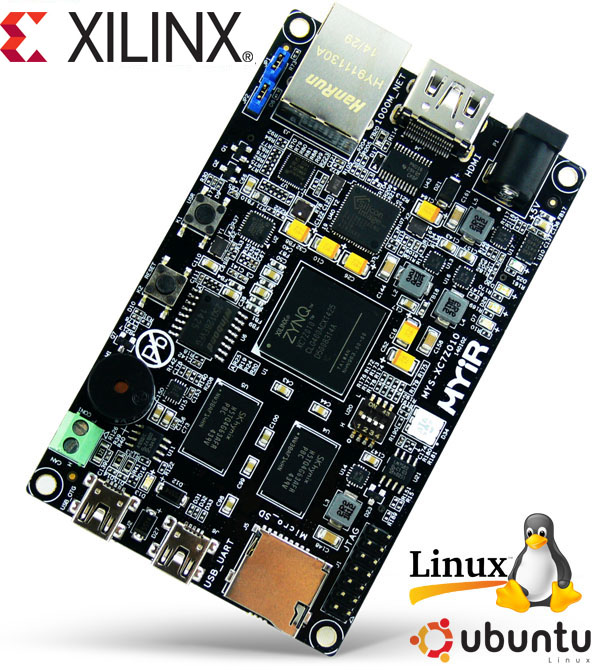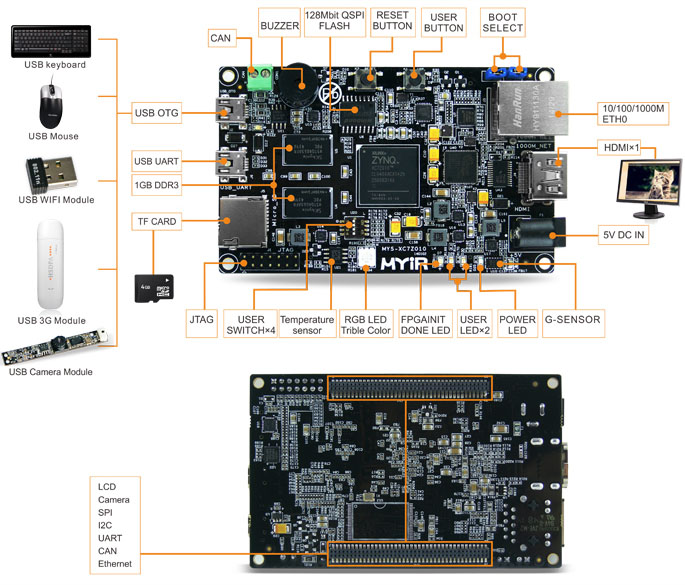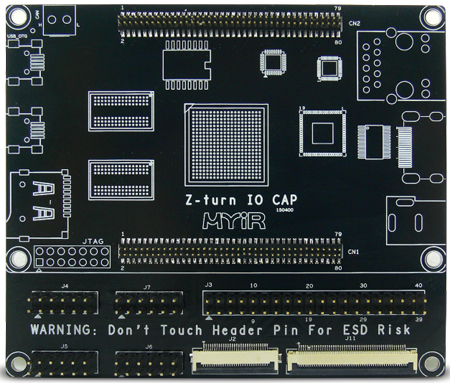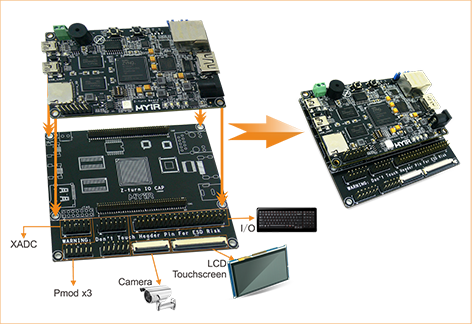MYIR is a Xilinx Alliance Member, welcome to use MYIR's Xilinx products!
We also offer ODM & OEM services, welcome your inquiry!
http://www.myirtech.com/xilinxseries.asp
The Z-turn Board is a low-cost and high-performance Single Board Computer (SBC) built around the Xilinx Zynq-7010 (XC7Z010) or Zynq-7020 (XC7Z020) All Programmable System-on-Chip (SoC) which is among the Xilinx Zynq-7000 family, featuring integrated dual-core ARM Cortex-A9 processor with Xilinx 7-series Field Programmable Gate Array (FPGA) logic.
The Z-turn Board takes full features of the Xilinx Z-7010 / Z-7020 SoC, it has 1GB DDR3 SDRAM and 16MB QSPI Flash on board and a set of rich peripherals including USB-to-UART, Mini USB OTG, 10/100/1000Mbps Ethernet, CAN, HDMI, TF, JTAG, Buzzer, G-sensor and Temperature sensor. On the rear of the board, there are two 1.27mm pitch 80-pin SMT female connectors to allow the availability of 96 / 106 user I/O and configurable as up to 39 LVDS pairs I/O.

Z-turn Board - Xilinx Zynq-7010 / 7020 Single Board Computer
The Z-turn Board is capable of running Linux operating system. MYIR has provided Linux 4.14.0 SDK, the kernel and many drivers are in source code. MYIR also provides a MYIR-PYNQ project to support Python
development on the Z-turn Board. The board is delivered with complete accessory kit including two USB cables, one Ethernet cable, one HDMI cable, one 16GB TF card and one 5V power adapter and product CD-ROM which enables you to start the development quickly when getting the board out-of-the-box. MYIR also offers optional WiFi and camera modules, Z-turn IO Cape for the Z-turn Board. The Z-turn IO Cape provides many peripheral signals and interfaces including ADC, GPIO, LCD, Camera and three Pmod interfaces.
The Z-turn Board is an excellent development platform for evaluating and prototyping for Zynq-7000 SoC. It can also be used as a System-on-Module (SOM) for your next embedded design; typical applications are Industrial Automation, Test & measurement, Medical Equipment, Intelligent Video Surveillance, Aerospace and military, etc.
Features
|
Item
|
Features
|
|
SoC
|
Xilinx XC7Z010-1CLG400 (Zynq-7010) or XC7Z020-2CLG400 (Zynq-7020)
- 667MHz ARM® dual-core Cortex™-A9 MPCore processor (up to 866MHz)
- Integrated Artix-7 class FPGA subsystem
with 28K logic cells, 17,600 LUTs, 80 DSP slices (for XC7Z010)
with 85K logic cells, 53,200 LUTs, 220 DSP slices (for XC7Z020)
- NEON™ & Single / Double Precision Floating Point for each processor
- Supports a Variety of Static and Dynamic Memory Interfaces
|
|
Memory
|
1GB DDR3 SDRAM (2 x 512MB, 32-bit)
|
|
Storage
|
16MB QSPI Flash
TF card interface
|
|
Communications
|
1 x 10/100/1000M Ethernet
1 x CAN
1 x Mini USB2.0 OTG
1 x USB-UART debug interface
|
|
Display
|
1 x HDMI (supports 1080p resolution)
- We offer reference design for HDMI and LCD display functions without limitation for its. The IP cores in the design are provided by Xilinx. MYIR will provide Vivado project and SDK testing programs.
- We also offer reference design for using evaluation version of Xylon's logiCVC-ML and logiCLK IP core. Please contact Xylon to buy the license of the IP core for logiCVC-ML or logiCLK.
http://www.logicbricks.com/Products/logiCVC-ML.aspx
http://www.logicbricks.com/Products/logiCLK.aspx
|
|
User I/O
|
Brought out via two 1.27mm pitch 80-pin SMT female connectors
- 90/106 user I/O (7010/7020)
- Configurable as up to 39 LVDS pairs I/O
|
|
Dimensions
|
63mm x 102mm x 1.6mm (8-layer PCB design)
|
|
Power supply
|
USB power supply or DC 5V/2A
|
|
Working Temp.
|
0~70 Celsius (commercial grade)
|
|
Others
|
Onboard three-axis acceleration sensor and temperature sensor
1 x 2.54mm pitch 14-pin JTAG interface
2 x Buttons (1x Reset, 1 x User)
4-channel toggle switch
5 x LEDs (3 x User LEDs, 1 x Power indicator, 1 RGB LED)
1 x Buzzer
|
|
OS support
|
Linux 4.14.0
|
|
Target Applications
|
Evaluation and Prototyping for Zynq-7000 AP SoC
Industrial Automation
Test & measurement
Medical Equipment
Intelligent Video Surveillance
Aerospace and military
|
Z-turn Board in the Video
- MYIR Z-turn Board Xilinx 7-series FPGA logic ARM Cortex-A9 System-on-Chip
- How to debug the Xilinx zynq-7020 Z-turn board 01
- How to debug the Xilinx zynq-7020 Z-turn board 02
- How to build a boot.bin bootstrap on Xilinx ZYNQ Z-turn board
- gpio mio project based on Xilinx zynq-7020 Z-turn board
- gpio emio project based on Xilinx zynq-7020 Z-turn board
- Hello world tutorial vivado

Z-turn Board
Z-turn IO Cape
  
Z-turn IO Cape (an IO extension board for Z-turn Board)

Z-turn Board Mounted on Z-turn IO Cape

Other MYIR's Xilinx Products
http://www.myirtech.com/xilinxseries.asp
Z-turn Lite Single Board Computer (based on Zynq-7010)
MYD-C7Z015 Development Board (MYC-C7Z015 CPU Module as core board, Zynq-7015)
MYD-Y7Z010/20-V2 Development Board (MYC-Y7Z010/20-V2 CPU Module as core board, Zynq-7010 / 7020)
MYD-C7Z010/20-V2 Development Board (MYC-C7Z010/20-V2 CPU Module as core board, Zynq-7010 / 7020)
MYD-CZU3EG/4EV/5EV-V2 Development Board (MYC-CZU3EG/4EG/5EV-V2 CPU Module as core board, ZU3EG/4EV/5EV)
FZ5 Card (AI Accelerator Card based on Zynq UltraScale+ ZU5EV MPSoC)
FZ3 Card - deep learning accelerator card (based on Xilinx Zynq UltraScale+ ZU3EG MPSoC)
|